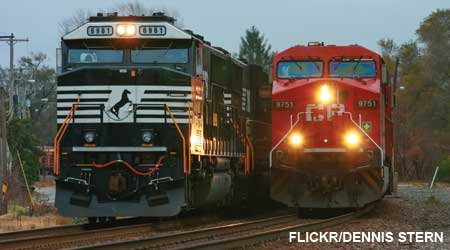Stay updated on news, articles and information for the rail industry
June 2008
Rail News: Rail Industry
From dieselization to computerization to consolidation, freight railroads have made industry-shaping strides
By Jeff Stagl, Managing Editor
To say the freight-rail industry has progressed since Col. John Stevens obtained North America’s first railroad charter in 1815 is an understatement. Considered the father of American railroads, Stevens demonstrated the feasibility of steam locomotion, which began a long, steady period of modernization in the industry. But it could be argued that the past half century has been the zenith of freight railroading’s evolution in North America.
The industry has transitioned from steam to diesel-electric to AC-traction locomotives, from handwritten to typed to radio and wireless communications, from cabooses to end-of-train devices, from 115-pound jointed rail to 141-pound continuous-welded rail and from three- to two-man crews, among dozens of advances.
Freight railroads also have introduced countless technological and operational innovations, including wayside detectors, rail grinding, fiber optics, distributed power and dynamic braking.
“We used to have depots with pot-belly stoves in the lobby,” says Copper Basin Railway President and Chief Operating Officer L.S. “Jake” Jacobson, recalling the industry’s somewhat primitive state — at least by today’s standards — when he launched his career with Union Pacific Railroad in 1958.
It’s been a remarkable evolution that Progressive Railroading and its predecessor Railway Materials (later, Railway Materials and Equipment) have tried to chronicle during the past 50 years. It’s also a progression we can only partially recount in the following pages as we explore the industry’s seminal events and milestones since Railway Materials Editor Philip Murphy in issue No. 1 (May/June 1958) offered readers $10 for each published suggestion as to how a manufacturer could help railroads do a better job through the development of new devices, tools and materials — a hint at R&D that continues to be crucial to today’s freight-rail advances.
Hellos and goodbyes
While they phased in the latest-and-greatest innovations the past 50 years, railroads also ushered in the Staggers Rail Act and deregulation, the rise of intermodalism (see page 32), Powder River Basin coal business, Conrail and hundreds of new short lines (see page 37). They ushered out more than 100 Class Is through bankruptcies or mergers — which trimmed their roster from 1958’s 110 to today’s seven — and dozens of short lines because of acquisitions and consolidations, as well.
In addition, railroads welcomed in the computer age, and began to adopt many electronic applications in the transportation, mechanical, MOW and C&S departments.
The dawning of the “electronic age” in the late 1950s and its impact on the industry wasn’t lost on Donald Hill, who as Northern Pacific Railway’s superintendent of communications wrote, “The potentialities for putting electronics to work for the railroads are tremendous,” in Railway Materials’ July/August 1958 issue.
“There is no reason, in the not too distant future, why electronics should not play a continuing larger part in efficient railroad operations,” he wrote.
It was a prophetic statement. Computers essentially run railroads today, says Mike Power, who witnessed computerization’s rise after entering the rail industry in 1963 as a summer MOW worker for the Great Northern Railway, and later held various operating, management and marketing positions at the Great Northern, Burlington Northern and Santa Fe railroads before retiring in 1999.
“I don’t know how we did it before,” he said during an April interview.
The dawn of diesel
The same sentiment could be expressed about freight railroads’ switch from steam to diesel-electric road locomotives by the late 1950s. Diesel locomotives could make long, sustained runs with only fuel and water servicing stops vs. steam locomotives that required intensive maintenance, lubrication and cleaning before, during and after use.
But not every rail executive whole-heartedly welcomed the conversion. In Railway Materials’ November/December 1958 issue, Illinois Central System General Superintendent of Motive Power John Welsch wrote: “The diesel has changed the routines followed by the railroads for maintenance of their motive power. The sad part of the picture is that the diesel up to now has curbed much of the ingenuity formerly exercised by railroad men in the maintenance of the steam locomotive where he could do his own development work on many of the devices used on that equipment.”
While diesel locomotives continued to arrive on freight roads’ systems — the Southern Pacific (SP) and Union Pacific (UP) railroads ran their last steam engines in revenue service in ’59 — intermodalism gained momentum in the 1960s. Container usage steadily increased and the International Organization for Standardization (ISO) established container standards to ensure interchangeability between modes.
Although railroads’ piggyback service was growing at the dawn of the ’60s, the industry needed more R&D to develop better piggyback equipment, such as cars, trailers and containers, wrote Transport Leasing Co. President Arthur Berry in Railway Materials and Equipment’s September/October 1960 issue: “The railroad supply industry has contributed much to the current progress in this area but in 1970, looking back, someone undoubtedly will observe that in 1960, the surface had hardly been scratched.”
Mergers and acquisitions
In the ’60s, Railway Materials and Equipment changed its name to Progressive Railroading. In addition, the industry marked several firsts. Missouri Pacific acquired the first solid-state computer (an IBM 7070) and Canadian National Railway Co. installed Canada’s first hot box detector in 1961, and SP purchased the first locomotive engineer training simulator in 1968.
Many mergers and acquisitions were consummated, as well, including Texas & Pacific’s control of the Kansas, Oklahoma & Gulf and Midland Valley Railways, Missouri Pacific’s (MP) control of the Chicago & Eastern Illinois Railroad (C&EI), and the Great Western’s merger with the Chicago & North Western (C&NW). The pinnacle of the decade’s mergers occurred in 1968, when the Pennsylvania, New York Central, and New York, New Haven and Hartford railroads combined and formed the Pennsylvania and New York Central Transportation Co., or Penn Central.
During the ’60s, trucks also emerged as a formidable rail competitor and took advantage of a serious industry-wide shortage of freight cars.
“Somewhere along the way, a big bomb labeled ‘C-O-M-P-E-T-I-T-I-O-N’ exploded and the railroads abruptly realized that they were in a pitched battle for a share of the country’s transportation market … a battle for which they were ill-prepared by virtue of years without competition,” wrote Northern Pacific Railway President Louis Menk in Progressive Railroading’s January/February 1968 issue.
He believed the industry was in an era that could best be described as “creative railroading.”
“This calls for in-depth exploration of all areas of railroading where we can make improvements by applying new ideas, unusual, even radical concepts and modern techniques,” Menk wrote.
Partner or perish
Competition with trucks continued into the ’70s, as did a flurry of M&A activity. In 1970, the Chicago, Burlington & Quincy, Northern Pacific, Great Northern, Spokane, Portland and Seattle, and Pacific Coast railroads merged to form the Burlington Northern Railroad. In 1976, Texas & Pacific and C&EI merged with MP, and — in a landmark development — Congress created Consolidated Rail Corp. (Conrail) after passing the Railroad Revitalization and Regulatory Reform Act of 1975 and merging seven bankrupt Northeast railroads.
The federal government stepped in to save the roads during what also became a decade of major railroad bankruptcies — none larger than Penn Central’s in 1970, which was traced to poor track conditions, a weak economy, sagging profits and limited cash flow, and led to the reform act and Conrail’s formation.
Penn Central’s bankruptcy was a “black eye” for the U.S. economy and underscored the futility of the Nixon Administration’s “high interest” rate policy on money as a means of stopping inflation, wrote Washington, D.C., observer and author Larston Farrar in a “Washington Reports” column in Progressive Railroading’s July/August 1970 issue.
“The bankruptcy of the huge Penn Central … caused only a slight initial tremor in the stock market, but the repercussions were expected to be much broader and deeper when realizations become more widespread,” he wrote. “Noted economic observers pointed out, even before the declaration of bankruptcy, that if Penn Central took that route, it would only be a matter of time before some six to 12 other railroads plunged into bankruptcy, too.”
The other bankrupt railroads included in Conrail were Lehigh Valley, Reading Co., Erie Lackawanna, Central Railroad of New Jersey, the Lehigh and Hudson, and Ann Arbor (which left the consolidated company shortly after Conrail’s formation). Conrail controlled more than 50 railroads and jointly owned and operated another 13 roads.
Conrail’s after-effects
The U.S. Railway Association (USRA), which Congress formed in 1974 to create Conrail’s final system plan, established a system that stood to resolve one of the fundamental causes of railroad bankruptcies in the northeast by reducing excessive plants and at the same time upgrading lines, terminals and networks to “today’s performance standards,” wrote Frank Richter, then Progressive Railroading’s publisher, in the January 1976 issue.
“The course of these different facets of the work toward realigning and revitalizing the railroads of the northeast could well be one of the most
remarkable combination of actions that has occurred in the history or railroads — and transportation, for that matter,” he wrote.
The USRA’s decision to exclude certain lines in Conrail’s final system plan led to the formation of about a dozen short lines, including the Gettysburg Railroad (created after the Pennsylvania DOT acquired a former Reading line) and Octoraro Railway (which took over Reading’s Wilmington and Reading branch). Several other short lines also launched operations in the ’70s, including R.J. Corman Railroad Group, Central New York Railroad and Providence & Worcester Railroad (all, 1973), and the Massachusetts Central and Middletown & Hummelstown railroads (both, 1975).
A ‘staggering’ achievement
As the ’70s drew to a close, many railroads continued to face stiff trucking competition and struggled financially. So, the industry sought regulatory relief — in addition to the revitalization and reform act — to gain control of rail rates and better compete with trucks.
Enter the Staggers Rail Act of 1980, which President Jimmy Carter signed into law Oct. 14 that year.
Arguably the single most important development of the past half century — and identified as such in an informal Progressive Railroading online survey — Staggers replaced a regulatory structure that had been in place since 1887’s Interstate Commerce Act and deregulated the railroad industry.
The act provided greater range for railroad pricing without close regulatory restraint, a higher degree of independence from collective rate-making procedures, a platform to establish contract rates with shippers, and more freedom for entering and exiting rail markets.
In a non-bylined article entitled “A ‘New Era’ for Railroads” in Progressive Railroading’s November 1980 issue, the act was hailed as a “milestone in legislation affecting railroads, both because of the long and tireless effort of many to give it birth and the impact expected on the industry’s future, and on the way railroads conduct every part of their business from now on.”
Under a “Fruits of Deregulation” sidebar, the article listed the following benefits of Staggers:
- rates could be raised 160 percent of variable costs without Interstate Commerce Commission (ICC) approval and railroads could boost rates 5 percent annually until 1984 “just to cover inflation”;
- railroads could “join freely” in contracts with shippers covering rates and service, regardless of commodity;
- railroads could apply surcharges or cancel joint rates if 110 percent of out-of-pocket costs weren’t recovered;
- ICC rail abandonment procedures were simplified, with a time limit of 330 days imposed on abandonment decisions; and
- Conrail would obtain an additional $500 million through 1981 for operations and the continuation of an existing excess employee/early retirement program.
Although the Staggers Act provided railroads much-needed rate freedom, a repercussion of the legislation took time — and more modernization — to address, says Arnold McKinnon, who served as Norfolk Southern Corp.’s chairman, president and CEO from 1987 to 1992 (see page 38 for more McKinnon insight).
“Shippers used it to create rate complications and forced railroads to make cuts and find savings,” he said during an April interview. “It took mechanization to offer the rates we offered.”
Revitalized and reborn
Staggers also prompted Class Is to spin off unprofitable branch lines, which were acquired by small railroads — leading to the short-line industry’s rebirth — and prompted a spate of railroad mergers. But unlike the mergers of the ’60s and ’70s that were intended to ensure certain railroads’ survival, the ensuing mergers were designed, in a sense, to make profitable railroads even more profitable.
During the ’80s, the Burlington Northern acquired St. Louis-San Francisco Railway; Seaboard Coast Line Industries and Chessie System merged and formed CSX Corp.; the Soo Line acquired the Minneapolis, Northfield and Southern, and Milwaukee Road; UP acquired the Missouri-Kansas-Texas Railroad; and SP merged with the Denver & Rio Grande Western. One major merger that didn’t happen: a SP-Santa Fe Industries marriage, which was rejected by the ICC in 1985.
In the small-railroad world, the decade included the formation of the Wisconsin & Southern, Wisconsin Central, Iowa Interstate, Iowa Northern, Montana Rail Link and Dakota, Minnesota & Eastern, among others, and holding companies RailAmerica, Watco Cos., Anacostia & Pacific and Pioneer Railcorp.
Defining moments
Other notable events in the ’80s include UP’s establishment of Bailey Yard in North Platte, Neb., as the world’s largest classification yard and initial access into the Powder River Basin; the creation of rail research facility Transportation Technology Center Inc. in Pueblo, Colo.; SP’s initiation of double-stack car sets; and J.B. Hunt Transport/Atchison, Topeka & Santa Fe’s start-up of “Quantum” truck/rail trailer service.
Featuring a single rate and common billing, Quantum service enabled SF to “offer door-to-door intermodal service in more markets,” wrote Santa Fe President Mike Haverty in a “Looking Ahead: 1990” letter published in Progressive Railroading’s January 1990 issue. “We will continue to pursue arrangements with other transportation companies to expand our market influence beyond our rails.”
Like the decades before it, the ’90s also were marked by a number of noteworthy developments — not the least of which were the mergers that defined and shaped today’s Class Is.
Canadian Pacific Railway acquired the Soo Line in ’90 and, the next year, obtained the bankrupt Delaware and Hudson Railway, which provided the Class I access to northeastern U.S. ports; CN, which privatized in ’95, acquired the Illinois Central in ’99; Burlington Northern and Santa Fe merged and formed BNSF Corp. in ’95; Kansas City Southern acquired MidSouth Rail in ’94 and Gateway Western Railway in ’96, and obtained a major interest in the Texas Mexican Railway in ’95 and Panama Canal Railway in ’98; and UP merged with C&NW in ’95 and with SP in ’96. The UP-SP marriage led to what was termed a “service meltdown” in the Houston area while the two railroads struggled to combine their operations.
Conrail carve-up
The ’90s closed with another significant merger — or, to be more accurate, integration: the carve-up of Conrail between CSX and NS. After waging a takeover battle to control what had become a profitable Conrail (which privatized in ’87) and expand their systems, CSX and NS struck a compromise agreement to jointly acquire the railroad and split most of its assets between them. The split occurred in June 1999.
NS acquired 58 percent of Conrail’s assets (including about 6,000 route miles) and CSX obtained 42 percent (including 3,600 route miles). In addition, per the STB’s decision on the transaction, a Conrail Shared Assets Area — which continues to serve as a CSX- and NS-owned terminal operating company — was established in north and south New Jersey, Philadelphia and Detroit.
Just as the combined UP-SP experienced operational problems after merging, CSX and NS confronted serious bottlenecks after integrating their Conrail shares. Shippers cited transit delays up to 12 hours immediately after the integration, as reported in Progressive Railroading’s July 1999 issue.
“At the beginning of Week Two, the delays were unconscionable; by the end of Week Two, they were horrific,” said United Parcel Service spokesman Norman Black in the article.
Officials at both Class Is worked to resolve post-Conrail glitches and rebuild shipper relationships through 1999 and into 2000.
“We’ve learned that there’s a fair amount of tolerance [from our customers] for failures,” said NS Chairman, President and CEO David Goode, as he was quoted in the July 1999 issue. “But there is no tolerance for not admitting them.”
Called-off marriages
The mergers that didn’t happen in the ’90s were just as interesting as the ones that did. UP dropped a bid to acquire the Sante Fe in ’95, opening the door for the BNSF merger; CN and CPR broke off talks to merge their eastern Canadian operations in ’94; and — in what would have formed North America’s largest railroad — BNSF and CN planned to merge in ’99 and form holding company North American Railways. However, the Surface Transportation Board, which in ’95 replaced the 108-year-old ICC, issued a 15-month moratorium on railroad mergers in 2000, which prompted BNSF and CN to drop their marriage plan.
“A major merger like this … could disrupt the industry for years [and] we risk further alienating our customers,” said Goode in opposition to the BNSF-CN merger at a STB hearing in March 2000, as reported in Progressive Railroading’s April 2000 issue. At the same hearing, CN President and CEO Paul Tellier, in reaction to criticism about the merger following so closely on the heels of the problematic UP-SP and Conrail transactions, said: “The timing is not the issue. There is no bad time for a good transaction.”
In a ‘minor’ key
So far in the 2000s, no major mergers have been proposed. However, several transactions considered “minor” marriages by the STB have been consummated. CN acquired Wisconsin Central in 2001, BC Rail in 2003 and Great Lakes Transportation’s rail holdings in 2004, and the DM&E acquired I&M Rail Link and formed the Iowa, Chicago & Eastern Railroad in 2002.
In other significant M&A developments this decade, RailAmerica acquired RailTex Inc. in 2000; KCS acquired Grupo TMM’s shares in TFM S.A. de C.V. in 2004; and Fortress
Investment Group acquired RailAmerica and Florida East Coast Railway in 2007. Two other transactions proposed last year remain under STB scrutiny: CPR’s acquisition of the DM&E and CN’s acquisition of a major portion of the Elgin, Joliet & Eastern Railway.
“The DM&E is an excellent fit for Canadian Pacific, making this a strategic end-to-end addition to our network,” said CPR President and CEO Fred Green, as quoted in Progressive Railroading’s October 2007 issue.
The 2000s also will be known as the dateline for a number of other milestones. CPR became an independent, publicly traded company in 2001; the U.S. DOT and AAR created the Surface Transportation Information Sharing and Analysis Center in 2002 to boost rail security after 9/11; the Alameda Corridor opened as an intermodal rail expressway serving Los Angeles-area ports and Class Is began to implement remote-control locomotive operations in 2002; and intermodal exceeded coal as railroads’ largest revenue generator in 2003.
In addition, two separate studies released in 2007 showed railroads need to spend about $148 billion to boost capacity, and between $175 billion and $195 billion to maintain market share in the coming years.
The Class Is learned earlier this decade that getting rid of excess capacity — such as by selling lines, retiring rolling stock and eliminating jobs — and cutting capital reinvestments in infrastructure weren’t the right course of actions to take prior to a demand surge in 2004.
They’ve since spent billions of dollars to try to regain and boost capacity, but doing so has placed a brighter spotlight on Class Is’ ability to earn their cost of capital.
“While we sound like a broken record on this, we need to address” the cost of capital, said BNSF Chairman, President and CEO Matt Rose in Progressive Railroading’s December 2003 issue. “If we can’t exceed it, you will see a decline in capital that goes into this business [and] that’s something we, as a country, don’t need.”
Best yet to come?
There are other developments lurking on the horizon that promise to greatly impact the freight-rail industry before the decade is out, such as the outcomes of the CPR-DM&E and
CN-EJ&E transactions, and the DM&E’s long-proposed PRB expansion project, and the implementation of electronically controlled pneumatic brakes and positive train control.
Railroads also will be watching with great interest the economy; the legislative shake out of “re-regulation” and tax credit bills, and the implications to their capital reinvestment and capacity expansion plans; fuel prices; and the trucking industry’s attempt to increase truck weight.
Industry observers wouldn’t refer to the present period as the “rail renaissance” if railroads hadn’t made mostly positive strides in the past and faced promising prospects in the future.
So, after five decades of numerous achievements, the best of times might be in store for freight railroaders — especially those that develop the capacity and reliable service needed to meet tomorrow’s demand.
“We’ve built up flexibility and surge capacity, but to meet our customers’ expectations, we have to have service consistency,” said UP Chairman, President and CEO Jim Young in Progressive Railroading’s January 2008 issue. 


 2025 MOW Spending Report: Passenger-rail programs
2025 MOW Spending Report: Passenger-rail programs
 Gardner steps down as Amtrak CEO
Gardner steps down as Amtrak CEO
 Guest comment: Oliver Wyman’s David Hunt
Guest comment: Oliver Wyman’s David Hunt
 Women of Influence in Rail eBook
Women of Influence in Rail eBook
 railPrime
railPrime








